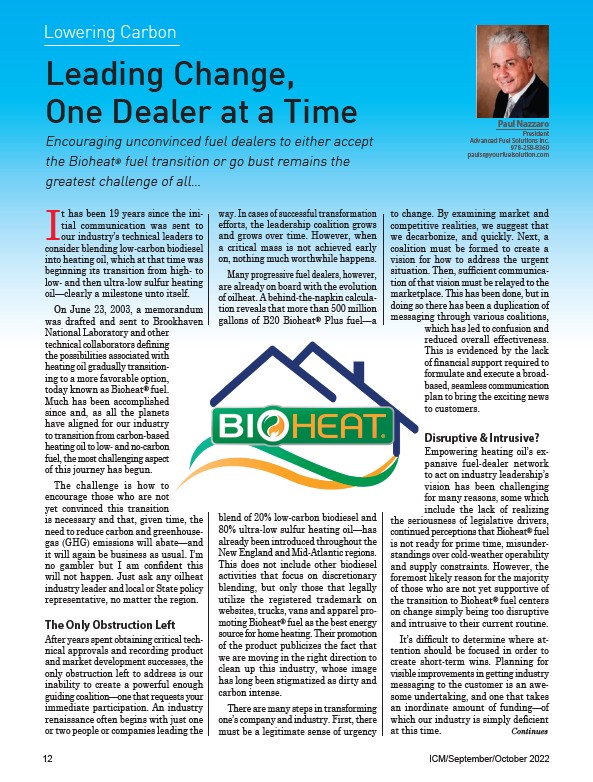
Lowering Carbon
Leading Change,
One Dealer at a Time
Paul Nazzaro
President
Advanced Fuel Solutions Inc.
978-258-8360
paulsr@yourfuelsolution.com
to change. By examining market and
competitive realities, we suggest that
we decarbonize, and quickly. Next, a
coalition must be formed to create a
vision for how to address the urgent
situation. Then, sufficient communication
of that vision must be relayed to the
marketplace. This has been done, but in
doing so there has been a duplication of
messaging through various coalitions,
which has led to confusion and
reduced overall effectiveness.
This is evidenced by the lack
of financial support required to
formulate and execute a broadbased,
seamless communication
plan to bring the exciting news
to customers.
Disruptive & Intrusive?
Empowering heating oil’s expansive
fuel-dealer network
to act on industry leadership’s
vision has been challenging
for many reasons, some which
include the lack of realizing
the seriousness of legislative drivers,
continued perceptions that Bioheat® fuel
is not ready for prime time, misunderstandings
over cold-weather operability
and supply constraints. However, the
foremost likely reason for the majority
of those who are not yet supportive of
the transition to Bioheat® fuel centers
on change simply being too disruptive
and intrusive to their current routine.
It’s difficult to determine where attention
should be focused in order to
create short-term wins. Planning for
visible improvements in getting industry
messaging to the customer is an awesome
undertaking, and one that takes
an inordinate amount of funding—of
which our industry is simply deficient
at this time.
Continues
Encouraging unconvinced fuel dealers to either accept
the Bioheat® fuel transition or go bust remains the
greatest challenge of all…
It has been 19 years since the initial
communication was sent to
our industry’s technical leaders to
consider blending low-carbon biodiesel
into heating oil, which at that time was
beginning its transition from high- to
low- and then ultra-low sulfur heating
oil—clearly a milestone unto itself.
On June 23, 2003, a memorandum
was drafted and sent to Brookhaven
National Laboratory and other
technical collaborators defining
the possibilities associated with
heating oil gradually transitioning
to a more favorable option,
today known as Bioheat® fuel.
Much has been accomplished
since and, as all the planets
have aligned for our industry
to transition from carbon-based
heating oil to low- and no-carbon
fuel, the most challenging aspect
of this journey has begun.
The challenge is how to
encourage those who are not
yet convinced this transition
is necessary and that, given time, the
need to reduce carbon and greenhousegas
(GHG) emissions will abate—and
it will again be business as usual. I’m
no gambler but I am confident this
will not happen. Just ask any oilheat
industry leader and local or State policy
representative, no matter the region.
The Only Obstruction Left
After years spent obtaining critical technical
approvals and recording product
and market development successes, the
only obstruction left to address is our
inability to create a powerful enough
guiding coalition—one that requests your
immediate participation. An industry
renaissance often begins with just one
or two people or companies leading the
way. In cases of successful transformation
efforts, the leadership coalition grows
and grows over time. However, when
a critical mass is not achieved early
on, nothing much worthwhile happens.
Many progressive fuel dealers, however,
are already on board with the evolution
of oilheat. A behind-the-napkin calculation
reveals that more than 500 million
gallons of B20 Bioheat® Plus fuel—a
blend of 20% low-carbon biodiesel and
80% ultra-low sulfur heating oil—has
already been introduced throughout the
New England and Mid-Atlantic regions.
This does not include other biodiesel
activities that focus on discretionary
blending, but only those that legally
utilize the registered trademark on
websites, trucks, vans and apparel promoting
Bioheat® fuel as the best energy
source for home heating. Their promotion
of the product publicizes the fact that
we are moving in the right direction to
clean up this industry, whose image
has long been stigmatized as dirty and
carbon intense.
There are many steps in transforming
one’s company and industry. First, there
must be a legitimate sense of urgency
12 ICM/September/October 2022